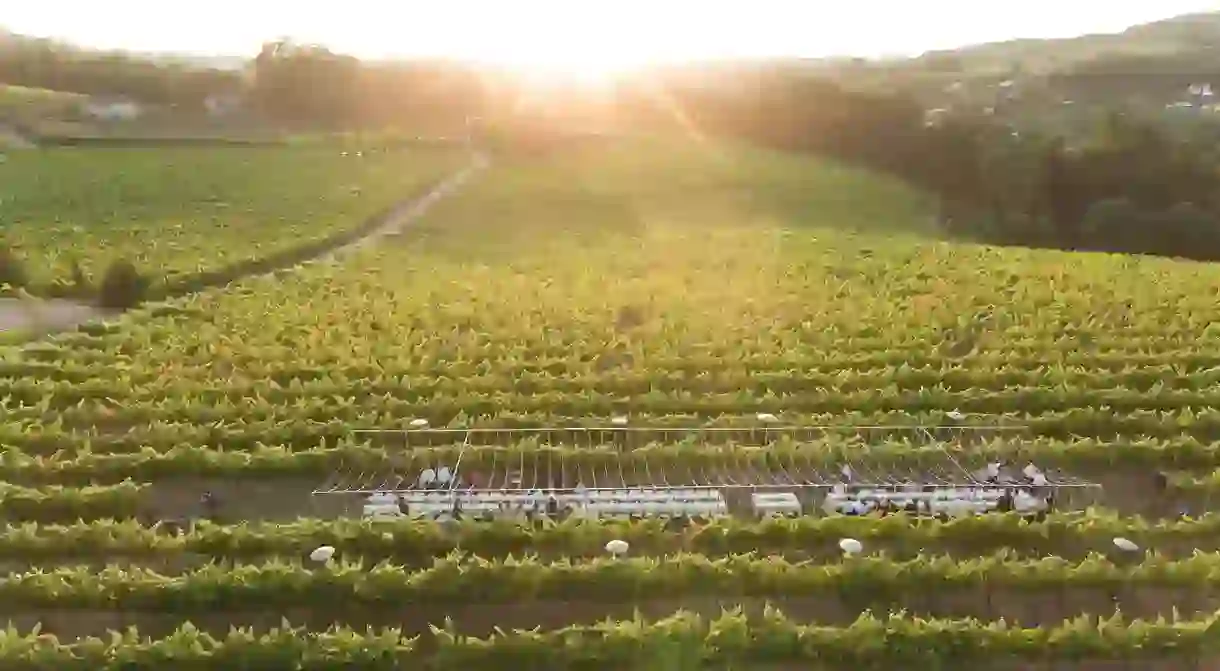Beyond the Douro: An Alternative North Portugal Wine Tour

Most oenophiles visiting the North of Portugal will head straight for the Douro Valley, and for good reason: the Unesco site promises an idyllic booze cruise through the home of port. But if you’ve been there, done that, we’ve got an alternative itinerary for you: one that takes in luxurious wine hotels, Roman rock wine presses and a once-disparaged region that’s defying expectations.
Friday night and Saturday morning: Get a taste of Porto
As the north’s nexus, Portugal’s second city has emerged from Lisbon’s shadow to become a culinary and cultural capital, in part fuelled by a graduate population that refuses to leave. Michelin-star restaurants jostle with wood-panelled bookshops and art museums, with the Douro River carving a sinuous line through it all. It’s joined up by the iron hulk of the Dom Luís I Bridge, designed by a disciple of Gustave Eiffel.
Check into a five-star wine hotel
Hotel
Pair an artistic dinner with the region’s finest tipple
Restaurant, Portuguese

With teal upholstery and hall-of-mirrors bathrooms, DOP is a mid-century daydream – but it’s the food you’re here for, and chef Rui Paula delivers. Cute codfish canapés accompany a dry Branco wine redolent of sea breezes; melty pork neck is paired with the leather and tobacco notes of Porta dos Cavaleiros. What’s more, the Instagrammable plates look as if they belong at the Espaço Mira art gallery down the road. Round off your meal with the spicy, in-your-face Burmester tawny port.
Explore Porto’s many-layered World of Wine
Museum

A relatively new addition to the city, World of Wine is yet another Adrian Bridge brainchild – a sprawling complex of six interactive museums, 10 restaurants, a wine academy, cookery school and shops, all in the historic Vila Nova de Gaia region. It’s almost comically literal in places – the Wine Experience exhibit lets you step inside a giant grape, while the Pink Palace is an homage to all things rosé. It’s tempered, however, by Bridge’s immense knowledge and respect for the region. If you can, squeeze in a tasting at the Wine School – but know that some sessions are conducted in Portuguese.
Saturday afternoon: Discover that there’s more to Vinho Verde than you thought
Virtually unknown in Europe outside of Portugal and Germany, Vinho Verde is one of the biggest-selling Portuguese wines in the United States – and has thus developed a reputation for being cheap and acidic. The former is still true – particularly if you buy a bottle in Portugal – but the character of this young “green wine” belies its years. It’s a lively, fresh tipple, perfect for summer sipping or paired with seafood.
Check into a family-owned vineyard hotel near Amarante
Hotel

Foremost in the rehabilitation of Vinho Verde’s reputation is the Hotel Monverde, which sits among acres of blazing green vines. These act as a baffle against the outside world, with solitary birds the only sound audible from the sun-trap terrace. You won’t want to rush this: spend lunch and dinner here and drink in the view, not to mention several wines. The hotel’s 30 rooms are understandably popular with wedding parties, so book well in advance.
Monverde produces 23 wines across reds, whites and rosés. The vineyard champions sustainable practices, turning unused grapes into fertiliser to grow the new crop. Guests can try the Wine Lover wine-blending experience or indulge in one of several tour and wellness packages, many of them tailored to couples. Book a five-wine tasting to discover the best of the crop – from citrusy Louveiro to inky Vinhão via minty Alvarinho and sparkling Touriga Nacional rosé. They’re wonderful alone, but the platter of bite-sized accompaniments – including cheeses, chutneys and chocolates – really makes them sing.
Lunch and dinner are served in the dining room – below the installation of 366 wooden vine leaves, each representing one working day on the vineyard (with an extra day for leap years). Meals resemble a large-scale pairing menu, curated to set off the fresh flavours of the region. Think duck confit with fig chutney, sea bass with razor clams, and chocolate-coated lychee. It’s all supported by artisan breads made in a local bakery and finished on site.
Sunday: Taste the ancient wines of Trás-os-Montes
You’ll know when you’ve crossed into Trás-os-Montes: manicured greenery gives way to scrubby hills and cliff-edge dirt roads. On the European culinary scene, Trás-os-Montes is known for almonds and olives – less so for wine, although the region’s output of full reds and floral whites is not to be sniffed at. In recent years, however, it’s caught wine lovers’ attention with its recreation of traditional Trasmontano wine using Roman-era rock presses.
Discover the region’s wine history (and snag souvenirs) at Casa do Vinho
Museum
Rustic Valpaços is the last place you’d expect to find Casa do Vinho, a high-tech interactive exhibition on the Trás-os-Montes wine industry. The displays – in Portuguese at the time of writing, but with an English translation imminent – dive deep into the history and process of local wine production. Scoop up wine, almonds, olives and honey at the well-stocked gift shop.
Drink wine made in a Roman press
Architectural Landmark
The countryside around Valpaços could not be more different to Porto’s buzz: tipsy cork trees line the roads, their bark scraped clean by enterprising locals; months-old oak trees spring from the ground like asparagus. It’s here that you’ll find some of the world’s oldest wine presses carved into the hillside, dating from Roman times. Contact a local tour operator such as Detours to taste the fruity Calcatorium wine made in these very presses, using traditional methods. Pour out a glass and toast the winemakers of old.













